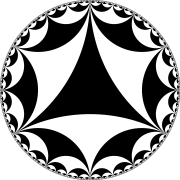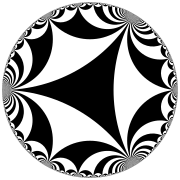Talk:Schwarz triangle
| This article is rated C-class on Wikipedia's content assessment scale. It is of interest to the following WikiProjects: | |||||||||
| |||||||||
Missing triangles
In the list of triangles for the icosahedral symmetry, 4 triangles are missing: (3/2 5 5/2), (3/2 5/4, 5/3), (3, 5/4, 5/2) and (3, 5, 5/3) [ contact [email protected] ] - 05:57, October 16, 2008 85.27.18.29
Shouldn't (3/2 4 4) be density 1?
Why is (3/2 4 4) listed as density 2? That's the triangle you get when you dissect (2 2 2) into three equal triangles meeting at the centroid of (2 2 2). So shouldn't it be density 1? --Vaughan Pratt (talk) 01:07, 3 October 2009 (UTC)
- All rational-ordered triangles have density of 2 or higher. They are listed in ]
Non-overlapping tilings of the plane
In fact ANY triangle, or any non-self-intersecting quadrilateral, can be used to tile the plane with no overlaps (simply start with a triangle or non-self-intersecting quadrilateral and add further congruent shapes by rotating existing shapes through 180 degrees about the midpoint of any side; in the case of a general triangle, adding another triangle in this fashion causes the two together to form a parallelogram, and it is easy to tile parallelograms in the plane). 86.4.253.180 (talk) 17:57, 11 April 2013 (UTC) 86.4.253.180 (talk) 17:57, 11 April 2013 (UTC)
- Schwartz triangles are by definition generated via reflection. Scalene triangle and quadrilateral tilings are not. — Cheers, Steelpillow (Talk) 22:12, 11 April 2013 (UTC)
Wrong title?
I was not able to find a paper with that title by Schwarz. Perhaps the paper "Ueber diejenigen Fälle, in welchen die Gaussische hypergeometrische Reihe eine algebraische Function ihres vierten Elementes darstellt" is meant? My German is not very good, sorry. Sam nead (talk) 12:59, 24 August 2013 (UTC)
- Yes, it seems that you are correct. The original reference goes back to Coxeter's Regular polytopes, where he gave the short title used in the header at the top of each journal page rather than the full title of the paper. He and his colleagues also reference it in their joint paper on Uniform polyhedra (Coxeter, Longuet-Higgins and Miller), where they appear to reference a page number inconsistent with the journal pagination. I have updated the reference in our article. — Cheers, Steelpillow (Talk) 15:12, 24 August 2013 (UTC)
ranking of numbers
I notice that where (p q r) are all integers they are listed in ascending order, but I haven't found a pattern where they are fractional. Any objecting to changing
| from | to |
|---|---|
| (2 3/2 3) | (3/2 2 3) |
| (3 4/3 4) | (4/3 3 4) |
| (3 5/3 5) | (5/3 3 5) |
| (2 3/2 3/2) | (3/2 3/2 2) |
| (2 3/2 4) | (3/2 2 4) |
| (2 3 4/3) | (4/3 2 3) |
| (2 3 5/2) | (2 5/2 3) |
| (2 5/3 5) | (5/3 2 5) |
| (3 5/3 5/2) | (5/3 5/2 3) |
| (3 5/4 5) | (5/4 3 5) |
| (2 3/2 4/3) | (4/3 3/2 2) |
| (2 3/2 5) | (3/2 2 5) |
| (2 3 5/3) | (5/3 2 3) |
| (3/2 4/3 4/3) | (4/3 4/3 3/2) |
| (3 3 5/4) | (5/4 3 3) |
| (3 5/4 5/2) | (5/4 5/2 3) |
| (2 3/2 5/2) | (3/2 3/2 2) |
| (3/2 3 5/3) | (3/2 5/3 3) |
| (2 3 5/4) | (5/4 2 3) |
| (2 5/4 5/2) | (5/4 2 5/2) |
| (2 3/2 5/3) | (3/2 5/3 2) |
| (2 5/4 5/3) | (5/4 5/3 2) |
| (2 3/2 5/4) | (5/4 3/2 2) |
| (3/2 5/4 5/3) | (5/4 3/2 5/3) |
| (3/2 3/2 5/4) | (5/4 3/2 3/2) |
| (3/2 5/4 5/4) | (5/4 5/4 3/2) |
| ? |
—Tamfang (talk) 00:21, 14 March 2014 (UTC)
- My only argument would be if there's a standard reference (Like Coxeter Table III) that lists them, even if not systematic, its easier to verify for errors. Coxeter always has 2 listed first in right triangles, and increasing fractional value otherwise? Tom Ruen (talk) 00:57, 14 March 2014 (UTC)
- Placing them in any order not found in a reference would fall foul of WP:OR. The list should follow Coxeter or someone similarly authoritative. — Cheers, Steelpillow (Talk) 13:54, 14 March 2014 (UTC)]
- Placing them in any order not found in a reference would fall foul of
removed a pic


I censored the first of these because it is not generated by reflections in a Schwartz triangle. Compare the second pic, which is. —Tamfang (talk) 06:15, 15 August 2023 (UTC)
- That's in the material User:Mathsci wrote right before he was banned. I'd definitely treat that section with a degree of suspicion. Apocheir (talk) 21:36, 15 August 2023 (UTC)
First paragraph says "possibly overlapping"
I'm a little confused by this - I thought tilings were non-overlapping by definition. Can anyone clarify? Fbm23.4 (talk) 16:14, 8 February 2024 (UTC)

